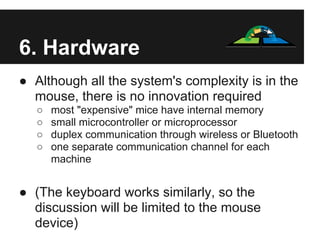Single input device for cross-machine manipulation
- 1. Single input device for cross-machine manipulation Cross-machine, cross-platform desktop manipulation with a single set of input devices
- 2. When working on multiple local computers, switching control across a few machines can be really painful. You either have to pick one machine and to remotely control all the others from there, or pick up another mouse and keyboard for each machine. This presentation shows a solution to reduce control to a single set of devices and virtually no network connection between machines to be needed. Abstract
- 3. Contents 1. Problems 6. Hardware 2. Motivation 7. Encapsulation 3. Idea 8. Mechanism 4. Graphical demo 9. Conclusions 5. Extend
- 4. 1. Problems ŌŚÅ Working on more machines at the same time involves a pair of input devices for each one of them ŌŚÅ Switch hand between mice is counterintuitive ŌŚÅ File transfer between machines nearby proves to be quite tedious (especially cross- platform)
- 5. 2. Motivation ŌŚÅ Improve productivity by keeping hands on the same mouse and keyboard ŌŚÅ Flawless and intuitive drag-and-drop file transfer and cross-machine copy-paste ŌŚÅ Minimize changes and additions needed for the system to work
- 6. 2. Motivation ŌŚÅ Why is this different from "remote desktop control"? ŌŚŗ No output overhead: ŌŚÅ Doesn't stream the whole output from the "remote" machine (including video) ŌŚŗ Faster: ŌŚÅ Remote-Control usually works over Internet which is a few orders of magnitude slower ŌŚŗ Accessibility: ŌŚÅ To improve speed, RC can run on LAN, but this involves more configs
- 7. 3. Idea ŌŚÅ Usual input devices to work would be great, but would involve complex machines config. ŌŚÅ So, empower the mouse ŌŚŗ Mouse = server ŌŚŗ Machines = clients ŌŚÅ The mouse is connected to all the computers and reasons about who it is currently controlling
- 9. Graphical demo Pointer initially active on M1 (Machine1)
- 10. Graphical demo Transition between displays of the same machine is naturally handled by the OS
- 11. We want to be able to jump to the other machine
- 12. The right (configurable) edge triggers the jump
- 13. The pointer becomes inactive on M1 and active on M2
- 14. Now the mouse controls M2
- 15. M2 has left screen edge configured to trigger a jump
- 16. You've been waiting for something to happen to that folder on M1, right?
- 17. Can do drag-and-drop file transfer cross-machine (even cross-platform)
- 18. Drag it all the way into the edge of screen
- 19. Activates the jump and file transfer too (more details later)
- 20. File transfer operation (like the usual one) initiates
- 21. Can jump around from a machine to the other...
- 22. ... just like the jump between screens on the same OS
- 23. 5. Extend ŌŚÅ The system can be extended to a virtually unlimited number of machines (For more than 4 neighbours to each machine, some other trigger could be used, instead of screen edges)
- 24. 6. Hardware ŌŚÅ Although all the system's complexity is in the mouse, there is no innovation required ŌŚŗ most "expensive" mice have internal memory ŌŚŗ small microcontroller or microprocessor ŌŚŗ duplex communication through wireless or Bluetooth ŌŚŗ one separate communication channel for each machine ŌŚÅ (The keyboard works similarly, so the discussion will be limited to the mouse device)
- 25. 7. Encapsulation ŌŚÅ Installation should be piece of cake: ŌŚŗ Install driver and software ŌŚŗ Establish connection to mouse Ō¢Ā Either insert one of the wireless receivers Ō¢Ā Either pair through Bluetooth ŌŚŗ Configure machines layout (visually) ŌŚÅ The driver delegates everything, keeping the complexity as much as possible encapsulated inside the mouse
- 26. 8. Mechanism ŌŚÅ Mouse behaves normally ŌŚÅ Screen edge is reached ŌŚŗ Driver on the active machine (M-old) sends notification to mouse ŌŚÅ Mouse switches the output channel to the new active machine (M-new) ŌŚŗ M-old becomes inactive by default, being ignored ŌŚŗ Mouse movement and actions are received only by M-new until a new jump event is encountered
- 27. 8. Mechanism Even file data is transferred: M1 -> Mouse -> M2
- 28. 8. Mechanism (files) ŌŚÅ Pointer activates a screen edge on M1 while dragging a file ŌŚŗ Software driver on M1 notifies the mouse about the jump and also requests to initiate file transfer ŌŚŗ Mouse switches output channel to M2 and notifies driver on M2 about the file transfer ŌŚÅ M2 accepts the transfer ŌŚŗ M1 starts streaming data to mouse ŌŚŗ Mouse forwards data to M2 ŌŚŗ On M2 additional file-system related changes are applied
- 30. 9. Conclusions ŌŚÅ Usability gain comes with some additional cost ŌŚŗ If the usual workflow involves more machines on the same desk, it should be worth it ŌŚÅ The system could be extended such as windows and processes could be dragged across different machines ŌŚŗ Better parallelism results from this
- 31. Custom made illustrations ┬® Iulius Curt This presentation is meant to propose a solution to an unsolved problem at the moment (although many work-arounds had been implemented) Iulius Curt ┬® february 2013 Single input device for cross-machine manipulation






























